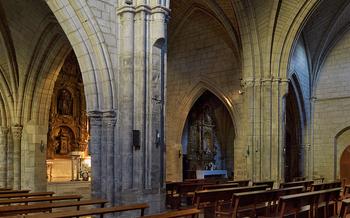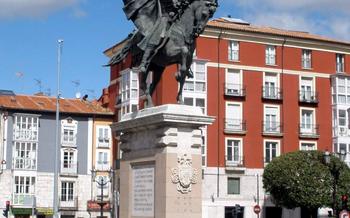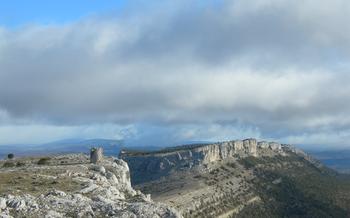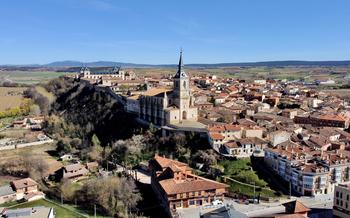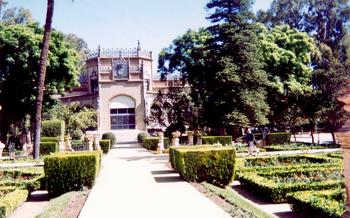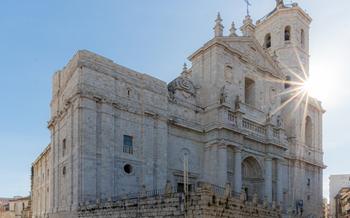
Dolmen de Cubillejo de Lara
- The Dolmen de Cubillejo de Lara: A Journey Through Time
- Unveiling the Mysteries: A Glimpse into the Past
- The Enchanting Surroundings: A Natural Paradise
- A Cultural Tapestry: Exploring the Local Heritage
- Step Inside the Time Machine: A Virtual Tour
- Practical Information for a Seamless Visit
- Capture the Moment: Photography Tips
- Unforgettable Experiences: Things to Do Nearby
- Legends and Folklore: A Touch of Magic
- Educational Opportunities: A Classroom in History
- Conservation Efforts: Preserving a Legacy
- Accessibility for All: Inclusive Experiences
- Community Involvement: A Sense of Belonging
- Ethical Travel: Respecting the Past
- Insider Tip: A Hidden Gem Awaits
The Dolmen de Cubillejo de Lara: A Journey Through Time
Amidst the rolling hills and fertile plains of the Spanish countryside, a testament to ancient ingenuity stands tall - the Dolmen de Cubillejo de Lara. This enigmatic megalithic structure, dating back to the Bronze Age, offers a glimpse into the lives and beliefs of our distant ancestors. Embark on a journey through time as we unveil the mysteries of this awe-inspiring dolmen, a symbol of human resilience and a reminder of the enduring power of tradition.
Location and accessibility:
The Dolmen de Cubillejo de Lara is situated in the province of Burgos, in the heart of the autonomous community of Castile and León, Spain. This Bronze Age monument can be easily accessed by road, following the N-234 highway and taking the exit towards Cubillejo de Lara. Once in the village, follow the signs that will lead you directly to the dolmen, nestled amidst picturesque landscapes.
Architectural features and design:
The dolmen showcases a remarkable architectural design, characterized by its impressive size and weight. Constructed using massive stone slabs, the dolmen consists of a large horizontal capstone resting on several vertical support stones, forming a chamber-like structure. The meticulous arrangement of these megaliths demonstrates the advanced engineering skills of the Bronze Age builders.
Cultural and religious implications:
The Dolmen de Cubillejo de Lara holds immense cultural and religious significance. It serves as a tangible reminder of the Bronze Age burial practices, where dolmens were used as collective tombs for the deceased. The careful placement of the dolmen, aligned with the cardinal points, suggests that it was likely used for astronomical observations and rituals, connecting the living with the cosmos.
Unveiling the Mysteries: A Glimpse into the Past
Archaeological excavations at the Dolmen de Cubillejo de Lara have revealed a wealth of artifacts and insights into Bronze Age burial practices. Among the discoveries are human remains, pottery shards, and tools, providing valuable clues about the lives and rituals of the people who built and used the dolmen. These findings suggest that the dolmen served as a collective burial site, with multiple individuals interred within its chamber. The presence of grave goods, such as pottery vessels and personal ornaments, indicates a belief in an afterlife and the desire to accompany the deceased on their journey.
The symbolic meanings and cultural significance of the dolmen are still debated among researchers. Some believe that the dolmen was a sacred place, used for religious ceremonies and rituals related to death and the afterlife. The alignment of the dolmen's entrance with the rising sun during the summer solstice has led to theories that it may have been used for astronomical observations or solar worship. Others suggest that the dolmen was a symbol of power and authority, perhaps associated with a ruling elite or a priestly class.
Preservation efforts at the Dolmen de Cubillejo de Lara are ongoing, with regular maintenance and restoration work carried out to ensure its longevity. Ongoing research and excavations continue to shed light on the site's history and significance, contributing to our understanding of Bronze Age cultures in the region.
The Enchanting Surroundings: A Natural Paradise
Nestled amidst the picturesque landscapes of Cubillejo de Lara, the Dolmen de Cubillejo de Lara stands as a testament to the harmonious coexistence of history and nature. The surrounding environment boasts a stunning array of natural wonders, creating a captivating tapestry that enhances the overall experience of visiting this ancient site.
The region is renowned for its diverse flora and fauna, offering a sanctuary for a variety of plant and animal species. As you explore the area, keep an eye out for the vibrant wildflowers, aromatic herbs, and majestic birds that call this place home. The gentle slopes and rolling hills provide the perfect backdrop for scenic hiking trails, allowing visitors to immerse themselves in the tranquility of nature while discovering hidden gems along the way.
For those seeking a more active experience, the region offers a range of outdoor activities that cater to all interests. Whether you prefer the thrill of mountain biking, the challenge of rock climbing, or the serenity of birdwatching, there's something for everyone to enjoy in this natural paradise. As you venture through the breathtaking landscapes, let the fresh air invigorate your senses and the stunning views soothe your soul.
A Cultural Tapestry: Exploring the Local Heritage
Cubillejo de Lara is not only home to the magnificent Dolmen but also a rich tapestry of cultural heritage and traditions. The village itself exudes a timeless charm, with its narrow cobblestone streets, whitewashed houses adorned with colorful flowers, and a vibrant main square that pulses with life.
Delve into the local customs and folklore, which have been passed down through generations. Attend one of the many festivals that celebrate the region's unique identity, such as the annual "Fiesta de la Cruz" (Feast of the Cross), where locals dress in traditional costumes and participate in lively processions and dances.
Discover the traditional crafts and artisanal products that are still lovingly created by skilled artisans in Cubillejo de Lara. From intricate pottery and hand-woven textiles to delicate lace and wood carvings, these creations showcase the village's artistic heritage.
Indulge in the region's delectable gastronomy, which features hearty stews, roasted meats, and an array of local cheeses. Savor the flavors of traditional dishes like "Olla Podrida" (a rich stew with chickpeas, meats, and vegetables) and "Lechazo Asado" (roast suckling lamb), accompanied by the region's renowned wines.
Step Inside the Time Machine: A Virtual Tour
In the realm of virtual exploration, the Dolmen de Cubillejo de Lara comes alive through captivating interactive tours and online resources. Embark on a journey through time from the comfort of your own home, immersing yourself in the dolmen's ancient mysteries.
-
360-Degree Panoramas and Immersive Experiences: Experience the dolmen as if you were standing right there, with interactive 360-degree panoramas that transport you to the heart of this Bronze Age monument. Explore the site from every angle, marveling at the intricate details of its construction.
-
Historical Reenactments and Educational Content: Delve deeper into the history and significance of the dolmen through engaging historical reenactments and educational content. Learn about the rituals and beliefs of the ancient people who built this enigmatic structure.
-
Accessibility for Those Unable to Visit in Person: Virtual tours provide an invaluable opportunity for those unable to visit the dolmen in person due to distance or physical limitations. Experience the wonder of this ancient site from anywhere in the world, bringing history to life in a truly accessible way.
Practical Information for a Seamless Visit
Whether you're a history buff, an outdoor enthusiast, or simply curious about the enigmatic past, planning a visit to the Dolmen de Cubillejo de Lara is an enriching experience. Here are some practical tips to ensure a smooth and enjoyable journey:
-
Opening Hours and Admission Fees: The dolmen is open to the public from 10 am to 5 pm, Tuesday through Sunday. Admission fees are minimal, with discounts for students and seniors.
-
Guided Tours: Enhance your visit with a guided tour led by knowledgeable experts. Tours are available in Spanish and English and provide in-depth insights into the history, architecture, and significance of the dolmen.
-
Recommended Time to Visit: The best time to visit the Dolmen de Cubillejo de Lara is during the spring or fall when the weather is pleasant, and the surrounding natural landscapes are at their most vibrant.
-
Facilities and Accessibility: The site offers basic facilities like restrooms and a small visitor center. Accessibility options for visitors with disabilities are limited, so it's advisable to contact the local tourism office in advance for assistance.
-
Travel Tips: To reach the dolmen, you can drive from Burgos, which takes approximately 1 hour and 30 minutes. Alternatively, you can take a bus from Burgos to Lara de los Infantes and then a taxi or local transportation to the site.
Capture the Moment: Photography Tips
Whether you're a seasoned photographer or just starting out, capturing the essence of the Dolmen de Cubillejo de Lara through your lens is an experience not to be missed. Follow these tips to elevate your photography and bring home stunning images that will transport you back to this ancient site.
-
Embrace the Golden Hour: The warm, diffused light of sunrise or sunset casts a magical glow on the dolmen, enhancing its textures and details. Plan your visit accordingly to take advantage of this golden hour and capture the site at its most photogenic.
-
Find Your Angle: Experiment with different angles to showcase the dolmen's grandeur. Shoot from a low perspective to emphasize its imposing size, or climb to a higher vantage point for a panoramic view that captures the surrounding landscape as well.
-
Compose with Intention: Use the natural elements of the site to create visually appealing compositions. Frame the dolmen with trees, rocks, or wildflowers to add depth and interest to your shots.
-
Respect the Site: While capturing your memories, remember to respect the sanctity of the dolmen. Avoid touching or climbing on the structure, and be mindful of other visitors who may be enjoying the site.
Unforgettable Experiences: Things to Do Nearby
Beyond exploring the Dolmen de Cubillejo de Lara, the surrounding region offers a wealth of other captivating attractions. Venture into the nearby town of Lara de los Infantes, a picturesque settlement steeped in history and charm. Immerse yourself in the town's rich heritage at the Museum of Lara, where fascinating exhibits shed light on the region's past. Discover the beauty of the Arlanza River, a natural wonder that meanders through the landscape, offering opportunities for serene walks and wildlife spotting. Embrace the region's adventurous spirit with outdoor activities like hiking, cycling, and birdwatching, immersing yourself in the breathtaking natural landscapes that surround the dolmen.
Legends and Folklore: A Touch of Magic
The Dolmen de Cubillejo de Lara is steeped in a rich tapestry of legends and folklore, adding an enchanting aura to its already captivating presence. Local myths and tales have been passed down through generations, intertwining with the history of the site and weaving a web of intrigue and wonder.
Stories of ancient rituals and supernatural occurrences dance around the dolmen, captivating the imaginations of visitors. Legends speak of mystical ceremonies conducted under the dolmen's massive stones, where shamans and druids communed with the spirits of the land. Whispers of strange lights and ghostly apparitions evoke a sense of awe and mystery, blurring the lines between reality and the realm of the unknown.
Oral tradition plays a crucial role in preserving the cultural heritage of the dolmen and the surrounding region. These stories, passed down from generation to generation, offer a glimpse into the beliefs and traditions of the people who have inhabited these lands for centuries. They connect visitors to the site's deeper essence, allowing them to experience a profound connection with the past and the enduring power of human storytelling.
Exploring the legends and folklore of the Dolmen de Cubillejo de Lara is like stepping into a realm where history, myth, and imagination converge. These tales add a layer of enchantment to the site, inviting visitors to embrace the magic and mystery that permeate the air, creating an unforgettable and truly immersive experience.
Educational Opportunities: A Classroom in History
The Dolmen de Cubillejo de Lara serves as an exceptional educational resource, offering a unique opportunity for students to immerse themselves in the history and cultural significance of the Bronze Age. School field trips and educational programs bring the past to life, allowing students to explore the dolmen, learn about archaeological methods, and uncover the secrets of ancient burial practices. Workshops and seminars delve deeper into the mysteries of the site, providing hands-on learning experiences and interactive exhibits that stimulate curiosity and encourage critical thinking. Through these educational initiatives, the dolmen becomes a living classroom, fostering a deeper understanding of our shared cultural heritage and inspiring future generations of archaeologists and historians.
Conservation Efforts: Preserving a Legacy
The Dolmen de Cubillejo de Lara stands as a testament to the enduring legacy of our ancestors. Preserving this historical site for future generations is of paramount importance, ensuring that its significance continues to be appreciated and understood. Ongoing restoration and maintenance projects are meticulously carried out to safeguard the integrity of the dolmen, employing traditional techniques and materials to maintain its authenticity. Sustainable tourism practices are also implemented to minimize environmental impact, ensuring that the site's natural beauty and surroundings remain undisturbed. Collaboration between local communities and heritage organizations is crucial in achieving these conservation goals, fostering a sense of shared responsibility and stewardship. By working together, we can ensure that the Dolmen de Cubillejo de Lara continues to captivate and inspire generations to come.
Accessibility for All: Inclusive Experiences
The Dolmen de Cubillejo de Lara is committed to providing an inclusive and welcoming environment for visitors of all abilities. Accessibility features have been implemented to ensure that everyone can enjoy the site's wonders. Wheelchair ramps and designated parking spaces make it easy for visitors with mobility challenges to navigate the grounds. Guided tours tailored for individuals with different needs are available, providing a personalized and informative experience. Audio guides and sensory experiences, such as tactile models and audio descriptions, enhance the visit for those with visual or hearing impairments. By catering to the diverse needs of visitors, the dolmen strives to create an accessible and enriching experience for all.
Community Involvement: A Sense of Belonging
The Dolmen de Cubillejo de Lara is not just a historical monument; it is a symbol of identity and pride for the local community of Cubillejo de Lara. The residents have played a crucial role in preserving and promoting the dolmen's cultural significance, initiating various community-led projects and initiatives.
Local associations and cultural groups organize regular events, workshops, and guided tours to showcase the dolmen's history and heritage to visitors and locals alike. These events celebrate the region's rich traditions, crafts, and folklore, fostering a sense of belonging and cultural identity among the community members.
Moreover, the community actively participates in restoration and maintenance projects, ensuring the dolmen's preservation for future generations. This collaboration between local stakeholders and heritage organizations demonstrates the deep connection and respect the community has for its historical legacy.
By engaging with local artisans, historians, and community members, visitors can gain a deeper understanding of the dolmen's significance beyond its historical value. These interactions provide a unique opportunity to connect with the local culture and contribute to the preservation of a shared heritage.
Ethical Travel: Respecting the Past
As responsible travelers, we have a duty to minimize our impact on the Dolmen de Cubillejo de Lara and its surroundings. This means respecting the site's cultural and historical significance, as well as the natural environment that surrounds it.
When visiting the dolmen, please stay on designated paths to avoid damaging the site's delicate structures. Refrain from touching or climbing on the stones, as this can cause erosion and damage to the ancient artwork.
It is also important to be mindful of the local community and their way of life. Support local businesses by purchasing souvenirs and products from local artisans, and respect local customs and traditions.
By practicing ethical and responsible tourism, we can help preserve the Dolmen de Cubillejo de Lara for future generations while also supporting the local community and its cultural heritage.
Insider Tip: A Hidden Gem Awaits
Beyond the Dolmen de Cubillejo de Lara, another hidden treasure awaits those seeking off-the-beaten-path adventures. Just a short distance away lies the Dolmen de San Felices, a lesser-known but equally fascinating megalithic monument. While smaller in size compared to its more famous counterpart, the Dolmen de San Felices offers a unique charm and tranquility that is often sought after by discerning travelers.
With its secluded location amidst picturesque landscapes, the Dolmen de San Felices invites visitors to step back in time and immerse themselves in the mysteries of the past. Its well-preserved structure showcases the ingenuity and craftsmanship of the ancient builders, providing a glimpse into the lives and beliefs of those who inhabited this region centuries ago.
Whether you're a history buff, an archaeology enthusiast, or simply a traveler seeking a serene escape, the Dolmen de San Felices is a hidden gem that should not be missed. As you explore this lesser-known site, you'll have the opportunity to connect with the past in a more intimate and personal way, creating memories that will last a lifetime.
